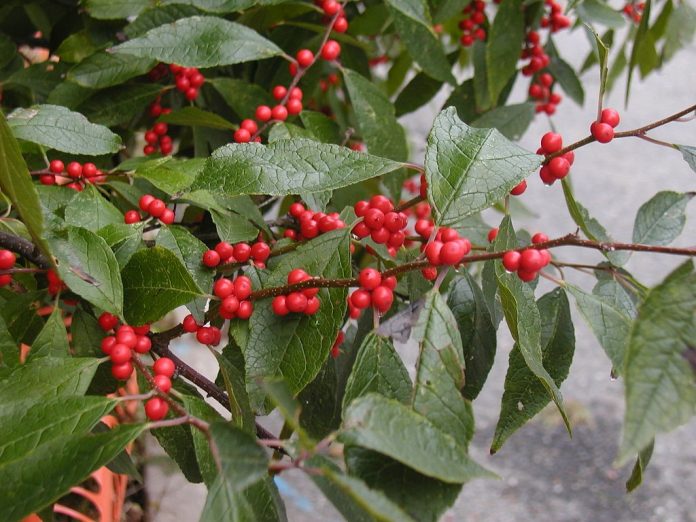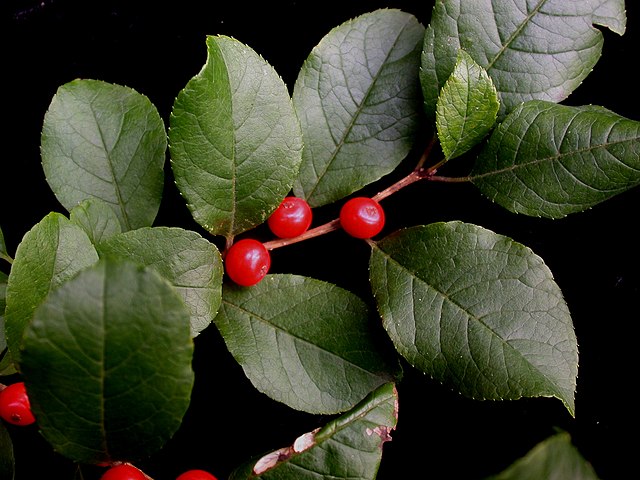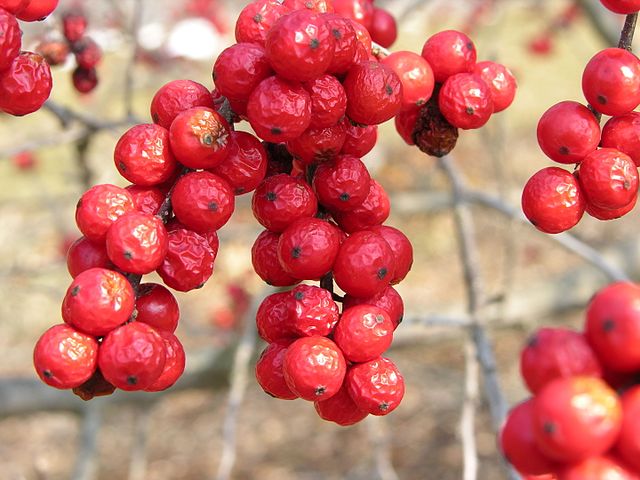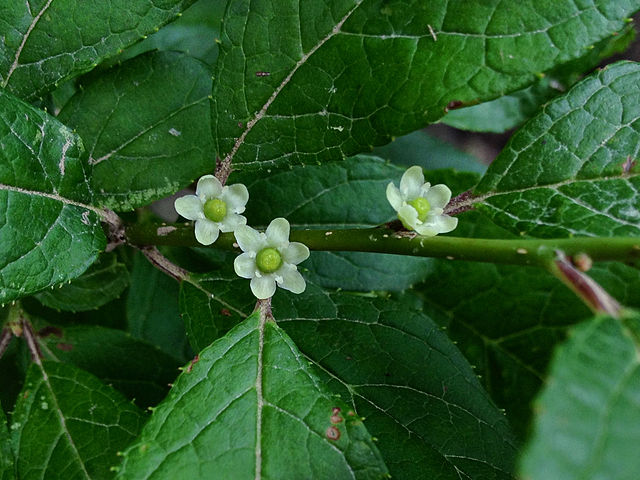
Feature Photo by SB Johnny / CC BY-SA 3.0
A field guide on how to identify and propagate Common Winterberry (Ilex verticillata), a hardy shrub that is native to eastern North America.
How to Identify Common Winterberry (Ilex verticillata)
Leaves

Common Winterberry leaves are elliptical to ovate-shaped, with spiky serrated margins, and grow on the stems in alternate arrangements. They feature a glossy, dark green color, providing an attractive backdrop to the vibrant berries.
Fruit

Common Winterberry produces bright red berries that persist through the winter, creating a stunning contrast against the shrub’s bare branches. These berries are a crucial food source for wildlife during the colder months.
Flower

The small, inconspicuous flowers of Common Winterberry bloom in clusters, featuring a greenish-white color. They are quite subtle and not especially showy.
Flowering Season
Common Winterberry typically flowers in late spring to early summer.
Habitat
Common Winterberry is commonly found in a variety of habitats, including moist woodlands, swamps, and along stream banks. It often associates with other understory plants, such as:
- Labrador Tea (Rhododendron groenlandicum)
- Bog Laurel (Kalmia polifolia)
- Lingonberry (Vaccinium vitis-idaea)
Wildlife Value
Common Winterberry provides essential food for wildlife, attracting birds such as robins, thrushes, and waxwings.
How to Propagate Common Winterberry (Ilex verticillata)

Hardiness Zone: 3-9

Soil Type: Well-drained peat moss, loam, sand.

Water: Normal to High.

Exposure: Full Sun to Partial Shade.
You can propagate common winterberry with two effective methods:
- Stem Cuttings: It provides established trees faster, but is tricky, and will probably have a lower success rate.
- By Seed: The success rate is high but takes longer to get established saplings.
How to Propagate Common Winterberry (Ilex verticillata) by Seed
You can harvest the seeds yourself if you have the time, and some wild plants nearby, here’s some tips:
How to Harvest Seeds
- Wait for Full Maturity: Begin by allowing the Winterberry fruits to fully mature on the shrub. This typically occurs in late fall when the berries are bright red and have reached their full size.
- Choose Healthy Berries: Select berries that are plump, fully colored, and free from any signs of disease or damage. Healthy berries are more likely to produce viable seeds.
- Harvesting: Gently pluck the berries from the branches using your fingers. You can also use small scissors or pruning shears to cut the berry-laden stems if you find it more convenient
- Extracting Seeds: To extract the seeds, crush the berries in a bowl or container. Use your hands or a spoon to break apart the pulp and expose the seeds.
- Washing Seeds: After crushing the berries, soak the mixture in water. Swirl the seeds around to separate them from the pulp. Viable seeds will sink to the bottom, while pulp and non-viable seeds may float.
- Straining: Pour off the pulp and floating seeds, leaving behind the sunken, viable seeds. You may need to repeat this process a couple of times to ensure you have clean, healthy seeds.
- Drying: Once the seeds are separated and cleaned, spread them out on a paper towel or a fine mesh screen to air dry. Allow them to dry thoroughly for a few days.
- Storage: Once completely dry, store the Winterberry seeds in a cool, dry place. Consider placing them in a labeled envelope or a small container for easy identification.
Stratification
Winterberry requires a stratification period for the seeds to properly germinate. They’ll require 60 days of warm-moist followed by another 60 days of cold-moist.
Sowing
You could sow them outside the in fall to self-stratify or simply start them indoors after you self-stratify.
How to Propagate Common Winterberry (Ilex verticillata) by Cuttings
The best time of the year to take winterberry cuttings is early spring when the plant is still dormant, this way you can give them the whole summer to root.

Although it’s still possible to take cuttings in the fall, plant them and they’ll survive through winter and start rooting the next season.
Here’s how:
- Select Healthy Branch: Choose a 4-6 inch healthy branch from the Winterberry shrub.
- Cut at a Slant: Use clean, sharp scissors to cut the branch at a 45-degree angle.
- Remove Lower Leaves: Strip off lower leaves, leaving only a few at the tip.
- Dip in Rooting Hormone: Dip the cut end in rooting hormone.
- Plant in Potting Mix: Insert the cutting into a pot with well-draining potting mix.
- Keep Moist and Wait: Keep the soil consistently moist and wait for roots to develop.
FAQ
Q: When is the best time to prune Common Winterberry?
A: The best time to prune Common Winterberry is in late winter or early spring before new growth begins. Remove dead or damaged branches and shape the plant as needed.
Q: How fast does Common Winterberry grow?
A: Common Winterberry is a relatively slow-growing shrub, gaining about 6 to 12 inches in height per year. Patience is key, as it establishes a strong root system before vigorous above-ground growth.
Q: Can I grow Common Winterberry in a container?
A: While it’s possible to grow Common Winterberry in a container, choose a large enough pot and use a well-draining, acidic soil mix. Ensure the container allows for the plant’s mature size and provides adequate moisture.
Q: Does Common Winterberry attract wildlife?
A: Yes, Common Winterberry is valued for its berries, which are a crucial food source for birds, including robins, thrushes, and waxwings. It enhances wildlife habitat and biodiversity.
Q: What is the hardiness zone for Common Winterberry?
A: Common Winterberry is hardy in USDA Zones 3 to 9, depending on the specific cultivar. Ensure your chosen variety matches the hardiness zone of your location for optimal growth.
